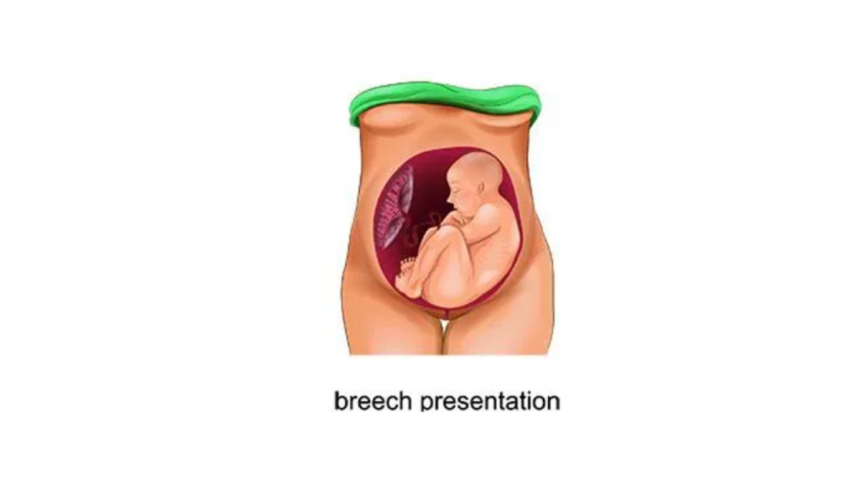Breech presentation refers to when the baby’s buttocks or feet are positioned to come out first instead of the baby’s head during childbirth. It occurs in 3–4% of all pregnancies.
After a breech delivery, the recurrence rate for a second pregnancy is 10%, while the rate for a third pregnancy is 27%.
To help you understand breech presentation, let’s first dive into the different types of breech birth presentations.
- Complete breech: The baby’s buttocks are pointed downward with the legs folded at the knees.
- Frank breech: The baby’s buttocks are pointed at the birth canal, with the legs pointing straight in front of his or her body.
- Footling breech: The baby’s feet are pointed downward and will come before the rest of the body.
How Breech Presentation Is Diagnosed
Detecting a breech presentation typically involves a combination of physical examination and imaging techniques.
A healthcare provider will carefully feel your abdomen to determine the position of the baby’s head, back, and buttocks. This is often done in the later stages of pregnancy.
They might also have to run an ultrasound scan to get a more visual assessment of the baby’s position. This imaging technique uses sound waves to create images of the baby inside the uterus.
If there’s a suspicion that the baby is in a breech position, additional ultrasounds may be performed to confirm the diagnosis and monitor the baby’s growth and development.
Causes of Breech Presentation
Here are the most likely causes of a breech situation:
- The presence of more than one baby in the uterus may lead to breech presentation.
- Presence of too much or too little amniotic fluid.
- Women with a history of premature delivery have a higher chance of having breech presentation.
- The uterus has an irregular shape. This may be due to the presence of fibroids that may give the uterus an irregular shape.
Can a Breech Presentation Be Changed?
Indeed, it is possible to change a breech presentation before childbirth. This is often attempted between the 32nd and 37th week of pregnancy.
External Cephalic Version (EVC) is a non-surgical technique used to turn the baby from a breech position (head-up) to a head-down position. This is usually done by:
- Administering medication to relax the uterus
- Gently pushing on the lower abdomen to guide the baby into the correct position
Throughout the procedure, the baby’s heartbeat is closely monitored to ensure their safety.
EVC has a high success rate and is often considered for women who have had a previous cesarean delivery. However, you should know that EVC carries some risks, including:
- Placental abruption
- Changes in the baby’s heart rate
- Preterm labor
If EVC is unsuccessful or not recommended, vaginal delivery may still be attempted in certain cases. This includes situations where
- The baby is not showing signs of distress
- The baby is full-term (37 weeks or later)
- The baby is in a frank breech presentation (head up, buttocks down)
- Anesthesia is available in case an emergency cesarean section is needed
Complications and Risks of a Vaginal Delivery for a Breech Birth

Here are the possible complications that you can expect:
- Umbilical Cord Compression: As the baby is guided through the birth canal, the umbilical cord may become compressed, leading to reduced oxygen and blood supply. This can affect the baby’s heart rate and overall well-being.
- Head Entrapment: The baby’s head may become stuck in the birth canal, requiring additional maneuvers or potentially a cesarean section.
- Shoulder Dystocia: The baby’s shoulders may become stuck after the head is delivered, leading to complications for both mother and baby.
- Fractures: In rare cases, the baby’s bones or arms may become dislocated during the delivery process.
Why Cesarean Delivery is Often Recommended
Due to the potential risks associated with vaginal breech delivery, healthcare professionals often recommend a cesarean section as a safer option. A cesarean delivery involves surgically removing the baby through the abdomen, avoiding the complications that can arise with vaginal breech births.
If you discover your baby is in a breech position, you should discuss with your healthcare personnel the various ways to change the position before the date of delivery. This should be done to prevent causing harm to the health of the baby.
Lynn Martelli is an editor at Readability. She received her MFA in Creative Writing from Antioch University and has worked as an editor for over 10 years. Lynn has edited a wide variety of books, including fiction, non-fiction, memoirs, and more. In her free time, Lynn enjoys reading, writing, and spending time with her family and friends.















